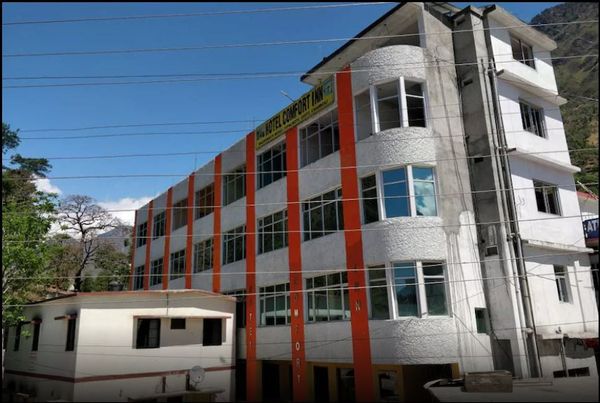Top 10 Most Beautiful National Parks in the World for Nature Lovers
 Mountains Curve
03 Aug, 2025
37 mins read
35
Mountains Curve
03 Aug, 2025
37 mins read
35
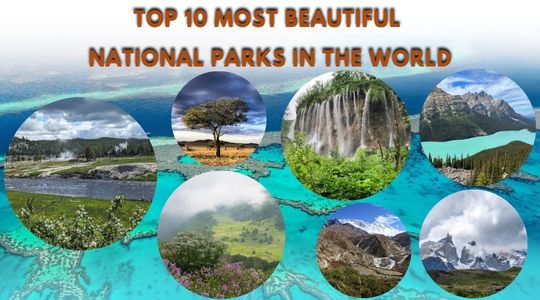
From towering glaciers and vibrant coral reefs to remote deserts and flower-filled valleys, national parks are most incredible natural showcases of Earth. Spread across every continent, these protected landscapes offer a rare mix of breathtaking scenery, ecological richness, and unforgettable outdoor experiences. Whether you are a hiker, wildlife enthusiast, photographer, or simply a curious traveler, national parks allow you to connect with nature in its rawest form.
In this blog, we highlight the Top 10 Most Beautiful National Parks in the World, each selected for its unique geography, biodiversity, and visitor appeal. These parks span from the snow-covered Himalayas to the African savannas, and from tropical islands to high-altitude valleys. You will also find an extended list of other must-visit national parks that deserve a spot on bucket list of every explorer.
So whether you are planning your next big trip or just fueling your wanderlust, this guide brings you closer to the most spectacular destinations of nature.
Let us explore them one by one:
1. Yellowstone National Park (USA)
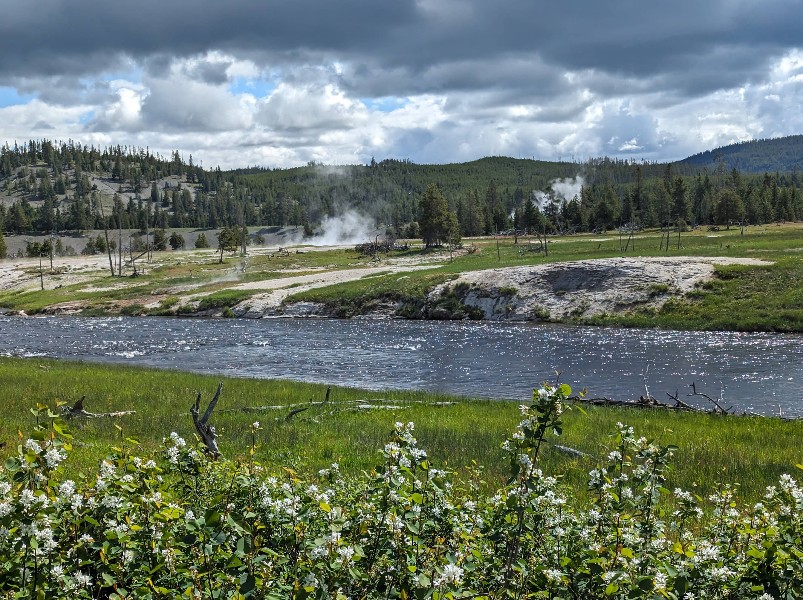
Yellowstone National Park (USA)
Established in 1872 as the first national park, Yellowstone sprawls across Wyoming, Montana, and Idaho. It preserves over 10,000 geothermal features, including geysers like Old Faithful, making it the most extraordinary hydrothermal region on Earth.
The diverse wildlife of the park is as famous as its geysers; roughly 300 bird species and 67 mammals roam Yellowstone (bison, elk, wolves, and bears). Mammals migrate seasonally and thrive in varied habitats from hot springs basins to high meadows. Visitors come for scenic canyons, alpine forests, and thermal wonders. Notable areas include the Grand Canyon of the Yellowstone, wildlife of Lamar Valley, and colorful hot pools.
- Highlights: Old Faithful geyser, Morning Glory Pool, Grand Prismatic Spring, Yellowstone Lake, Lamar Valley (wildlife viewing).
- Ecology: A UNESCO World Heritage site known for geothermal activity and large mammal herds.
- Tips: Drive the Grand Loop Road, watch for bison on the roads, and stay safe viewing wildlife at a distance.
2. Serengeti National Park (Tanzania)
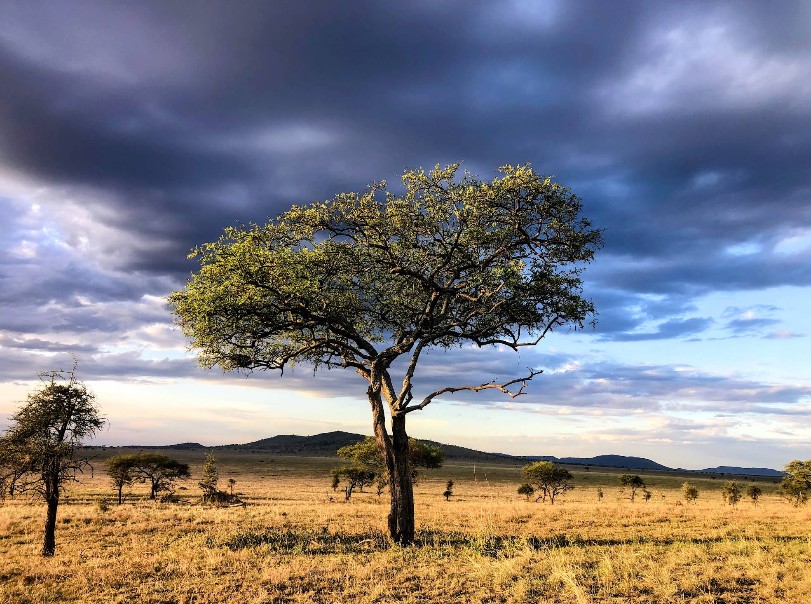
Serengeti National Park (Tanzania)
Serengeti NP covers about 15,000 km square of savannah and woodlands in the northern plains of Tanzania. It is famous for the Great Wildebeest Migration, roughly 1.5 million wildebeest (plus zebras and gazelles) moving seasonally in search of pasture. This UNESCO-listed park supports >70 species of large mammals and numerous predators (lions, cheetahs, hyenas, elephants). The endless grasslands and iconic acacia woodlands create classic safari scenery. Key highlights include the herds crossing crocodile-filled rivers, large prides of lions, and remote kopjes (rock outcrops) like Moru and Simba for panoramic views.
- Highlights: Annual migration (June to October for river crossings), predator sightings, varied landscapes (grassland, acacia forests).
- Ecology: Renowned savannah ecosystem (UNESCO site) hosting greatest variety of plains game of Africa.
- Tips: Visit during the dry season (July to September) for best wildlife viewing, and consider guided safari drives.
3. Galapagos National Park (Ecuador)

Galapagos National Park (Ecuador)
Galapagos NP protects about 97% of the Galapagos Islands (roughly 8,000 km square of land and marine area), famed as a living laboratory of evolution. This UNESCO World Heritage site harbors unique species found nowhere else: giant tortoises (up to 400 kg, >100-year lifespan), marine iguanas, blue-footed boobies, and finches of Darwin. Volcanic landscapes yield stark scenery of lava fields dotted by forests and beaches. Visitors can snorkel among tropical fish, observe playful sea lions, and trek rugged trails. Highlights include swimming with penguins at Punta Tombo (Magellan penguins), hiking Sierra Negra volcano, and watching the iconic tortoises in their natural habitat.
- Highlights: Giant tortoises, marine iguanas, blue-footed boobies, and vibrant reef life.
- Ecology: One of the richest marine reserves, this remote park was the first in Ecuador and is critical for conservation.
- Tips: Travel by small boat or cruise between islands; bookings and permits are required to protect sensitive habitats.
4. Great Barrier Reef Marine Park (Australia)
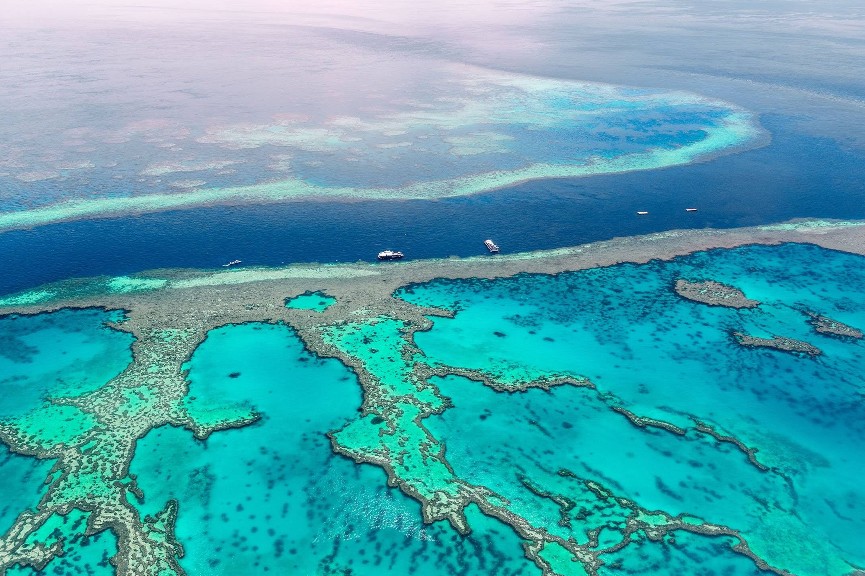
Great Barrier Reef Marine Park (Australia)
Stretching over 2,300 km along northeast coast of Australia, the Great Barrier Reef is the largest coral reef system (about 348,000 km square) of the world. Comprising around 2,500 individual reefs and 900 islands, this UNESCO site is famed for its spectacular marine biodiversity: 400 coral species, 1,500 fish species, turtles, dolphins, and dugongs among them. Stunning underwater landscapes of multicolored corals and reef fish create some of the most beautiful scenery on Earth. Above water, islands dot turquoise seascapes and tropical rainforests. Key highlights include snorkeling/scuba diving at vivid coral gardens, seeing giant clams, and visiting reef outlook platforms (e.g., Green Island, Whitsunday Islands).
- Highlights: Barrier Reef cruises, coral viewing (from air or glass-bottom boats), Whitehaven Beach (Whitsundays).
- Ecology: Global coral hotspot (UNESCO heritage) and essential habitat for endangered dugongs and green turtles.
- Tips: Plan visits during coral spawning (November) or peak marine life visibility (June to October); beware of coral bleaching impacts.
5. Plitvice Lakes National Park (Croatia)
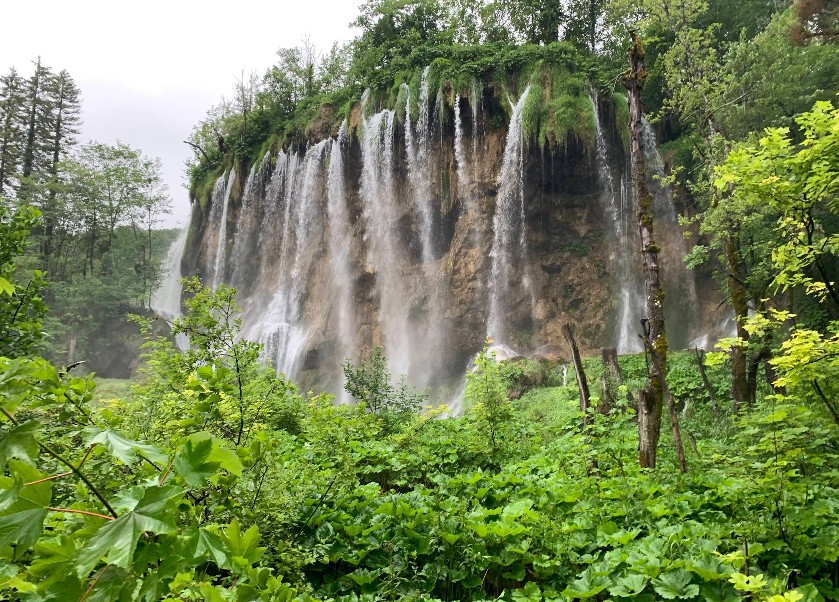
Plitvice Lakes National Park (Croatia)
Plitvice Lakes NP is a UNESCO-listed park in the karst mountains of Croatia, covering 296.85 km square. It is celebrated for its cascading travertine lakes and waterfalls, formed by limestone deposits over millennia. Sixteen terraced lakes flow into one another through series of falls and caves, surrounded by dense beech-spruce forests. Seasonal colors transform the scenery, emerald waters contrasting with autumn reds or snowy landscapes. Wildlife is abundant: bears, wolves and many rare birds inhabit the woodlands. Visitors can walk wooden boardwalks right over the lakes and hike forest trails, making it one of the most photogenic parks of Europe.
- Highlights: Big Waterfall (Veliki Slap), hiking trails (stone and wooden pathways across lakes).
- Ecology: Outstanding natural beauty from travertine geology; habitat for large carnivores (bears, wolves) and endemics.
- Tips: Arrive early or off-season to avoid crowds; follow marked trails to protect fragile vegetation.
6. Sagarmatha National Park (Nepal)
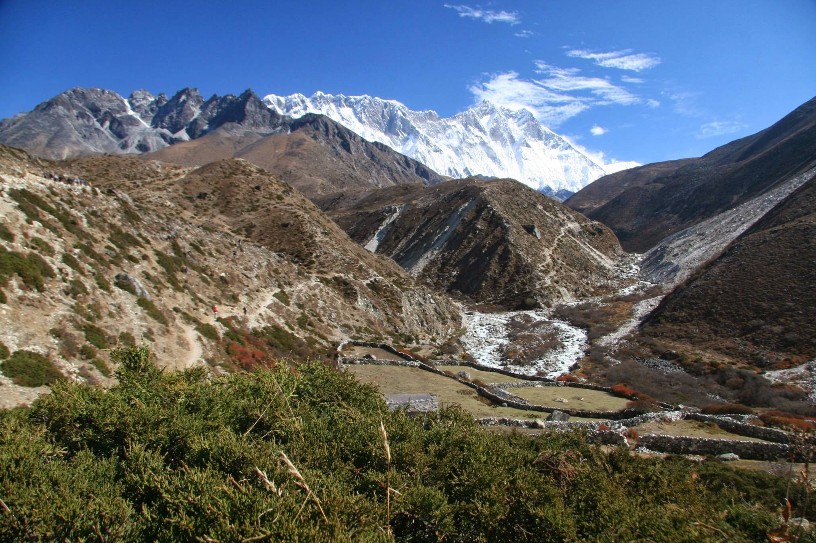
Sagarmatha National Park (Nepal)
Sagarmatha NP spans 1,148 km square in the high Himalaya of eastern Nepal. Sagarmatha is the Nepali name for Mount Everest (8848 m), which lies within the park boundary. Elevation of the park ranges from 2,845 m in valleys up to the summit of Everest (highest point on Earth). This rugged landscape of snowy peaks, deep valleys and alpine glaciers is globally iconic. Over 200 bird species and mammals (Himalayan tahr, musk deer, snow leopard) inhabit diverse zones; the snow leopard patrols alpine slopes above 3,500 m. The visitor highlights of Sagarmatha include Sherpa culture in Namche Bazaar, high-altitude lakes (Gokyo Lakes), and trekking routes like the Everest Base Camp trek for unrivaled mountain vistas.
- Highlights: Mount Everest, Khumbu Icefall, Himalayan glaciers, Sagarmatha summit viewpoints.
- Ecology: UNESCO World Heritage site recognizing Himalayan biodiversity and geology.
- Tips: Trekking is demanding, acclimatize properly; permits are required, and travel in spring/fall for best weather (avoid monsoons).
7. Valley of Flowers National Park (India)
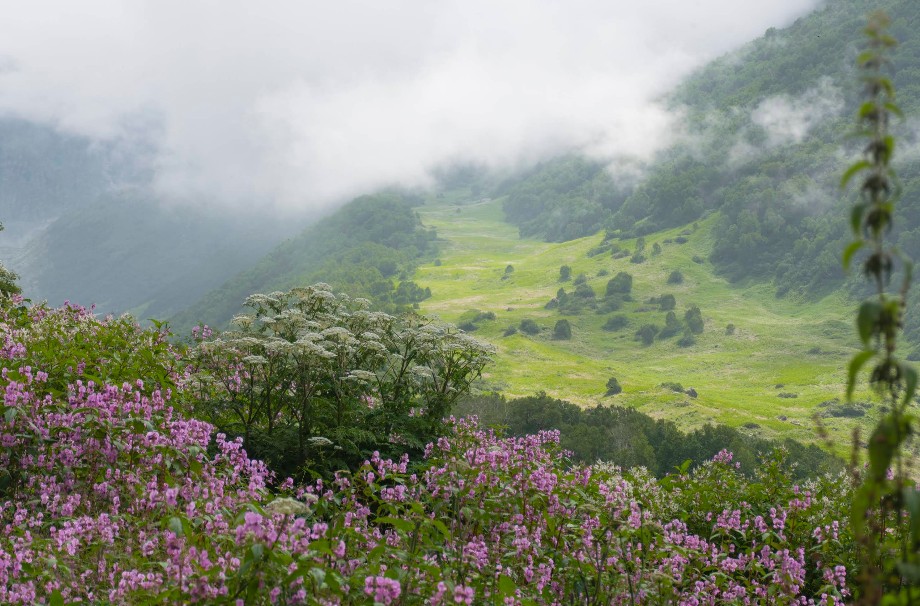
Valley of Flowers National Park (India)
Valley of Flowers National Park lies in the Chamoli district of Uttarakhand, India, nestled in the Western Himalayas at an altitude of 3,200 to 6,700 meters. Spanning around 87.5 km square, this UNESCO World Heritage Site is renowned for its scenic trail, charming meadows of alpine flowers, with over 600 species of flowering plants that carpet the valley during the monsoon (July to September). The park is part of the Nanda Devi Biosphere Reserve and also hosts endangered species like the snow leopard, musk deer, and Himalayan monal. It offers an immersive experience for botanists, trekkers, and photographers. The journey begins at Govindghat, covering approximately 40 km round-trip over 5 to 6 days. The trail involves a challenging ascent and unfolds breathtaking views of the snow-laden peaks that encircle Hemkund Sahib. The trail to the valley starts from Ghangaria and passes through lush forests, wooden bridges, and waterfalls.
- Highlights: Vibrant monsoon wildflowers (July to Sept), Pushpawati River, snow-covered peaks, rare Himalayan flora and fauna.
- Ecology: A protected alpine valley rich in biodiversity, it supports endemic Himalayan plant species and is part of a larger biosphere reserve with Nanda Devi.
- Tips: Best visited between mid-July and mid-August for peak bloom; no overnight stays allowed in the valley; requires a permit.
8. Banff National Park (Canada)
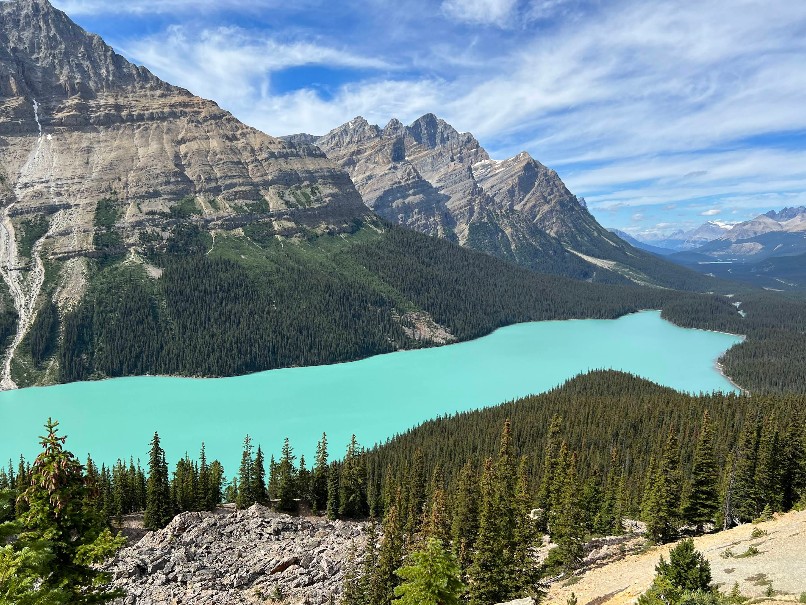
Banff National Park (Canada)
Banff NP is the oldest national park of Canada, covering 6,641 km square in the Rocky Mountains of Alberta. It is part of the Canadian Rocky Mountain Parks UNESCO World Heritage Site, renowned for rugged peaks, glaciers, and alpine lakes. Classic scenes include turquoise glacial lakes (Lake Louise, Moraine Lake) set against pine-clad mountains and the snowy Columbia Icefield. Wildlife such as elk, grizzly bears, and mountain goats roam subalpine forests and meadows. The Trans-Canada Highway and scenic park roads like the Icefields Parkway provide easy access to highlights: Bow Falls, Sulphur Mountain gondola, and Bow Lake.
- Highlights: Lake Louise, Peyto Lake, Johnston Canyon, hiking trails (Plain of Six Glaciers), Cave and Basin hot springs.
- Ecology: Part of a spectacular mountain landscape with icefields and waterfalls.
- Tips: Summer is peak season (July to Aug); winter offers skiing. Arrive early at popular lakes to avoid crowds and parking limits.
9. Torres del Paine National Park (Chile)
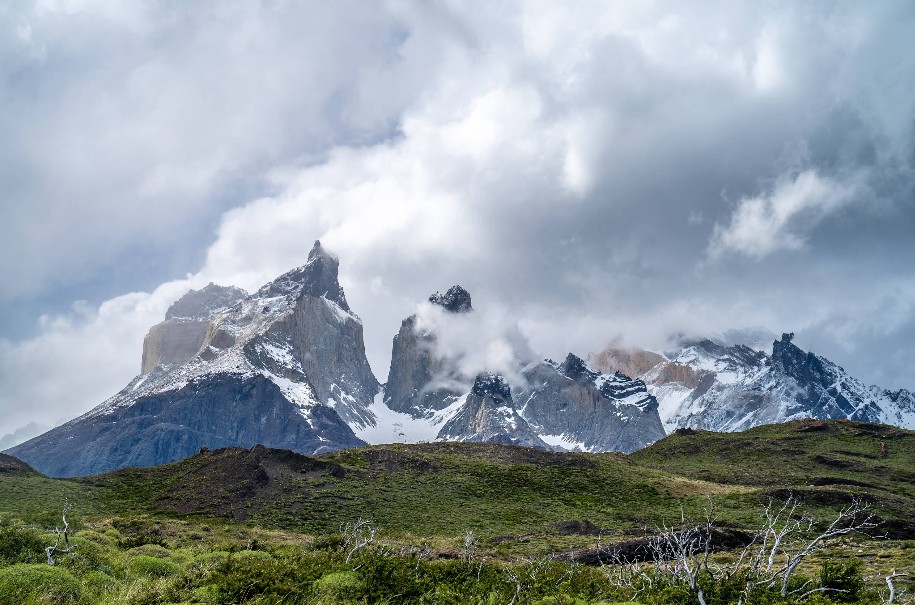
Torres del Paine National Park (Chile)
Torres del Paine NP in Chilean Patagonia (1,814 km square) is famed for dramatic granite peaks rising from Patagonian grasslands. Bright blue glacial lakes (Pehoe, Grey) lie at the base of the torres (tower-like granite spires) and the Paine massif. Snowfields and glaciers (Grey, Tyndall, Dickson) spill into lakes, framing a spectacular vista of jagged peaks and ice. The wildlife of park includes guanacos (wild llamas), Andean condors and elusive pumas. Popular attractions are the iconic towers seen from Base de las Torres, the French Valley viewpoint, and multi-day treks like the W-circuit.
- Highlights: The three Paine Towers at sunrise, Grey Glacier boat tours, French Valley viewpoint, Salto Grande waterfall.
- Ecology: UNESCO Biosphere Reserve; showcases subpolar forests, Patagonian steppes, and southern ice fields.
- Tips: Spring (Oct to Nov) brings wildflowers; summer (Dec to Feb) is warmest but crowded. Weather can change hourly, bring windproof layers.
10. Kruger National Park (South Africa)
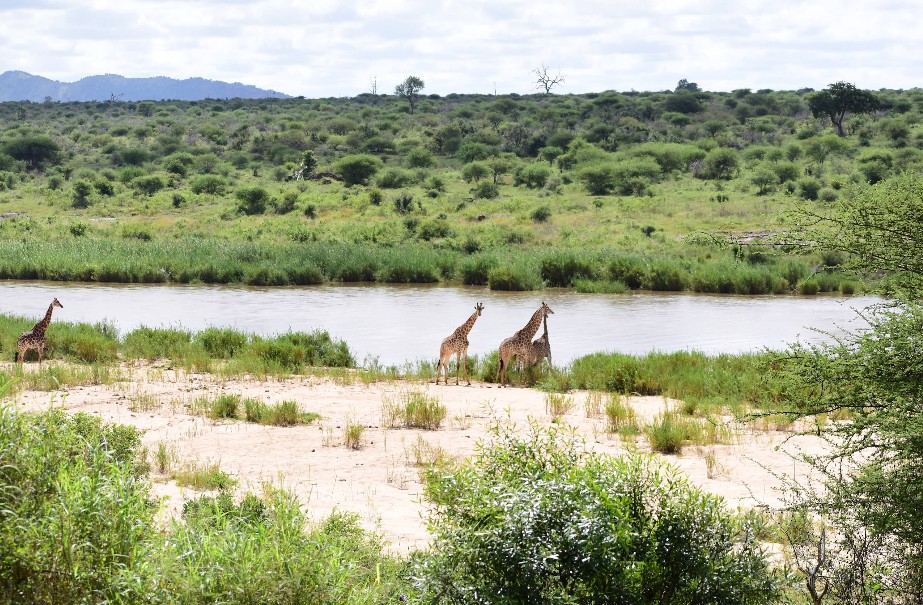
Kruger National Park (South Africa)
Kruger NP spans roughly 19,485 km square of African savanna in northeastern South Africa. It is one of the largest game reserves Africa. Kruger is famous for its Big Five safari wildlife: lions, elephants, buffalo, leopards and rhinos, all occur here, along with 147 species of large mammals. Mixed grasslands and woodlands provide varied habitats; nocturnal safaris and game drives yield sightings of cheetahs, hyenas, and herds of giraffe, zebra and impala. The extensive dirt road network and camps of the park make self-driving safaris possible. Its combination of year-round wildlife viewing, extensive biodiversity, and conservation success makes Kruger a top African park.
- Highlights: Big Five game viewing, scenic rivers (Sabie, Olifants), birdlife (600+ species), and malaria-free areas in the south.
- Ecology: One of the most biodiverse parks of Africa, Kruger sustains large animal populations and includes portions of the Greater Kruger conservation area.
- Tips: Best game viewing in dry winter (May to Sept); bring binoculars and arrive at dusk or dawn for predator activity.
Other Beautiful National Parks in the World
1. Fiordland National Park
- Location: South Island, New Zealand
- Accessibility: Accessible by road from Te Anau; boat tours and scenic flights available from Queenstown or Milford Sound
- Best Time to Visit: November to April (spring to early autumn) for hiking and boat cruises
Fiordland is a UNESCO World Heritage site known for iconic fjords like Milford and Doubtful Sound, lush rainforests, and cascading waterfalls. Ideal for kayaking, cruises, and multi-day hikes like the Milford Track.
2. Aoraki/Mount Cook National Park
- Location: Canterbury region, South Island, New Zealand
- Accessibility: 4.5-hour drive from Christchurch or 3.5 hours from Queenstown
- Best Time to Visit: December to March for trekking; June to August for alpine photography and stargazing
Dominated by Mount Cook (Aoraki), tallest peak of New Zealand, this park offers glaciers, alpine trails, and the darkest skies in the Southern Hemisphere for astrophotography.
3. Jasper National Park
- Location: Alberta, Canada, part of the Canadian Rockies
- Accessibility: Well connected by road via Icefields Parkway from Banff or Edmonton; nearest airport in Edmonton
- Best Time to Visit: June to September for hiking, wildlife viewing; November to March for skiing and ice walks
Known for its remote wilderness, glacier lakes, and hot springs, Jasper is less crowded than Banff but equally stunning, with ample opportunities for wildlife encounters and stargazing.
4. Goreme National Park
- Location: Cappadocia region, central Turkey
- Accessibility: Nearest airports in Kayseri (75 km) and Nevsehir (40 km); local buses/taxis to Goreme town
- Best Time to Visit: April to June and September to November for pleasant weather and ballooning
Famous for its fairy chimneys and cave dwellings, this park blends natural rock formations with ancient human settlements. Sunrise hot air balloon rides are a must.
5. Namib-Naukluft National Park (Namibia)
- Location: Namib Desert, western Namibia
- Accessibility: 5 to 6 hours by road from Windhoek to Sesriem Gate; 4x4 recommended for deeper access
- Best Time to Visit: May to October (dry season) for clear skies and cooler temperatures
Home to the iconic red sand dunes of Sossusvlei and Deadvlei, it is one of the most photogenic deserts in the world, with surreal light and shadow landscapes.
6. Rapa Nui National Park
- Location: Easter Island, 3,700 km west of mainland Chile in the South Pacific
- Accessibility: Flights from Santiago (LATAM Airlines, ~5 to 6 hours); permits required for park entry
- Best Time to Visit: April to October for cooler weather and fewer tourists
This park protects the mysterious Moai statues and volcanic craters of Easter Island. It is a unique combination of natural beauty and ancient Polynesian culture.
7. Volcanoes National Park (Rwanda)
- Location: Northwestern Rwanda, near the town of Musanze
- Accessibility: 2 to 3 hour drive from Kigali International Airport
- Best Time to Visit: June to September and December to February for dry-season gorilla trekking
Home to the endangered mountain gorillas, this park offers life-changing guided treks through misty volcano forests. Permits are limited and must be booked in advance.
8. Canaima National Park (Venezuela)
- Location: Southeastern Venezuela, Gran Sabana region
- Accessibility: Accessible by small plane from Ciudad Ciudad Bolivar; tours required for remote access
- Best Time to Visit: June to November (wet season) for full flow of Angel Falls
Famous for Angel Falls (tallest waterfall of the world) and flat-topped mountains called tepuis, Canaima is remote, wild, and otherworldly, ideal for explorers.
9. Simien Mountains National Park
- Location: Northern Ethiopia, near the city of Gondar
- Accessibility: Flights to Gondar, then 2 to 3 hours by road; local guides are mandatory
- Best Time to Visit: October to April (dry season); green post-rain views in September
A high-altitude park with dramatic escarpments and endemic wildlife like the gelada baboon and Ethiopian wolf. Ideal for multi-day trekking and photography.
10. Lencois Maranhenses National Park (Brazil)
- Location: Maranhao state, northeastern Brazil
- Accessibility: Reach Barreirinhas town by road from Sao Luis; 4x4 vehicles or guided tours needed inside park
- Best Time to Visit: June to September, when freshwater lagoons are full after rains
A unique desert landscape of sand dunes interspersed with freshwater lagoons. Visitors can swim in the natural pools and explore by foot or dune buggy.
11. Swiss National Park (Switzerland)
- Location: Eastern Switzerland, canton of Graubunden
- Accessibility: Easily reached by train or car from Zernez or Scuol towns
- Best Time to Visit: Late June to mid-October (open season); closed in winter for conservation
The only national park in Switzerland offers protected alpine landscapes, marmots, ibex, and strict trail rules that keep the wilderness pristine.
12. Los Glaciares National Park
- Location: Santa Cruz Province, southern Patagonia
- Accessibility: From El Calafate by road; nearest airport is Comandante Armando Tola International Airport
- Best Time to Visit: November to March (summer) for hiking and glacier tours
Known for the Perito Moreno Glacier and Fitz Roy mountain range, this park is a trekking paradise with dramatic icefields and turquoise lakes.
13. Jiuzhaigou Valley National Park (China)
- Location: Northern Sichuan Province, China
- Accessibility: Flights to Jiuzhai Huanglong Airport; shuttle buses to park entrance
- Best Time to Visit: September to November for fall foliage; spring (April to May) for vibrant colors
A magical valley with multicolored lakes, snow-capped peaks, and cascading waterfalls. Home to giant pandas (rarely seen), it is a top ecotourism site in China.
14. Samaria Gorge National Park
- Location: Crete, southwest part of the island
- Accessibility: Bus or car from Chania to Omalos; hike ends in Agia Roumeli (accessible by ferry)
- Best Time to Visit: May to October; closed in winter due to flooding risk
This 16-km gorge hike takes you through towering limestone cliffs and scenic woodlands, ending at the Libyan Sea. A popular day hike with stunning views.
Conclusion
From geyser fields to glacier lakes and coral reefs, these ten national parks showcase the most spectacular natural wonders of Earth. Each park combines scenic grandeur with rich ecology: they protect key habitats (from tropical reef systems to alpine tundra) and iconic species. Together they exemplify global diversity, vibrant marine life in Australia, savanna migrations in Africa, towering peaks in Asia and the Americas, and unique island fauna in the Galapagos and Komodo. As an experienced traveler would note, visiting these parks offers both adventure and education: staying informed about local regulations, seasons, and conservation measures ensures a safe, rewarding experience.
Frequently Asked Questions
Q: What is the best time of year to visit these national parks?
A: Timing varies by park. For example, Yellowstone and Banff are best in summer (June to Aug) for open roads; dry season (June to Oct) of Serengeti yields peak wildlife; Galapagos is good year-round with warm seas; Torres del Paine is best late spring/summer (Oct to Mar); Great Barrier Reef sees best clarity in winter (Jun to Oct). Always check park-specific seasons and weather.
Q: Do I need permits or guides to enter these parks?
A: Most parks require an entry fee or permit. Galapagos and Sagarmatha strictly require permits; Komodo needs boat permits. Guided tours are mandatory in some areas (e.g. Galapagos, Komodo). Even in self-drive parks (Yellowstone, Kruger), hiring a local guide or doing ranger-led programs enhances safety and experience.
Q: What wildlife can I expect to see?
A: Each park has signature fauna. Yellowstone: bison, elk, bears, wolves. Serengeti/Kruger: big cats and ungulate herds (wildebeest, zebras, buffalo, lions). Galapagos: endemic iguanas, tortoises and diverse birdlife. Sagarmatha: Himalayan species (snow leopards, tahr, musk deer). Komodo: dragons, deer, marine sharks. Torres del Paine: guanacos, condors, huemul deer. Great Barrier Reef: fish, turtles, sharks. Plitvice/Banff: deer, bears, eagles.
Q: Are these parks family-friendly?
A: Generally yes, but accessibility varies. Yellowstone, Banff, and Plitvice have boardwalks and easy trails suitable for families. Grand-canyon style parks like Torres del Paine and Sagarmatha involve strenuous hikes (children and elderly should be cautious). Komodo and Galapagos tours often have age restrictions. Always choose activities (hiking level, boat trips) appropriate for all members.
Q: How many days should I spend in each park?
A: It depends on travel style. A quick visit (2 to 3 days) can see main sights in compact parks (Plitvice, Komodo, Sagarmatha). Larger parks warrant a week or more: Yellowstone (5 to 7 days) to explore all regions, Serengeti (4 to 6 days for safari), Great Barrier Reef (several dive/snorkel trips), Torres del Paine (w trek needs 5 days), Kruger (4 to 7 days for multiple regions). Plan extra time for travel and acclimatization.
Q: What are the biggest environmental threats to these parks?
A: Threats include climate change (coral bleaching on GBR, melting glaciers in Sagarmatha/Torres del Paine), invasive species (Galapagos), and human impact (tourism pressure in Yellowstone, Plitvice crowding). Poaching and habitat loss threaten wildlife in African parks. All parks face balancing conservation with visitor access. Supporting park fees and guidelines helps protect them.
Q: Do I need special vaccinations or precautions?
A: Yes, depending on region. For example, tropical parks (Galapagos, Komodo) may require malaria prophylaxis and protection against dengue/mosquitoes. Kruger also has malaria risk in some areas. Vaccinations like Yellow Fever are required for some African parks if arriving from endemic countries. Himalayan parks (Sagarmatha) demand altitude acclimation and travel insurance. Always consult travel medicine advice before visiting.
Q: Can I drive my own vehicle in these parks?
A: In North America (Yellowstone, Banff) and Kruger, self-driving is common and well-supported by park roads. Serengeti offers some self-drive routes but 4 by 4 vehicles are needed in rainy season. In Galapagos, Sagarmatha, Komodo, and Torres del Paine, access is by boat or on foot (no private vehicles on Galapagos islands, Sagarmatha only trails). Always check park regulations on vehicle access.
Q: What accommodation options are available?
A: Varies widely. Yellowstone, Banff, and Kruger have in-park lodges and campgrounds. Torres del Paine and Serengeti have a range of refugios/camps or lodges inside park or nearby. Sagarmatha has teahouse lodges along trekking routes. Galapagos and Komodo rely on nearby towns or live-aboard boats. Remote parks may require backcountry camping permits. Book well in advance, especially in peak seasons.
Q: Are drones allowed for photography?
A: Most parks prohibit private drone use due to safety and wildlife disturbance (Yellowstone, Serengeti, Galapagos, Torres del Paine all ban drones). Some parks have strict no-drone policies enforced by fines. Always check rules: professional permits are rarely granted. Instead, use cameras with telephoto lenses.
Q: How much does it cost to visit?
A: Entry fees vary: Yellowstone (per car or per person), Galapagos ($100+ entry, plus cruise fees), Great Barrier Reef (marine park fee per dive/snorkel boat), Sagarmatha ($30+ permit), Banff (park pass per day), Torres del Paine ($30 entry), Kruger ($10 per person per day). Accommodation, guides, and transport add to cost. Many parks require booking fees for permits or camping.
Q: Is it safe to travel alone?
A: Solo travel can be safe if you prepare. In U.S./Europe parks (Yellowstone, Banff, Plitvice), solo driving/hiking is common. In remote or wildlife-heavy parks (Kruger, Serengeti), caution is needed, afternoon game drives or traveling with guides increases safety. Sagarmatha solo trekking is strenuous and requires permit/check-in. Always inform someone of your plans, carry emergency gear, and follow park safety guidelines.
Q: What special gear do I need?
A: Essentials depend on park: sturdy hiking boots and warm layers for mountain parks (Banff, Sagarmatha, Torres); swim/snorkel gear for marine parks (GBR, Galapagos); sun protection and insect repellent for savanna parks (Serengeti, Kruger). Camping equipment if staying overnight. Always carry plenty of water, maps/GPS, and park guides. In high-altitude parks, medications for altitude sickness are advised.
Q: Can I see all these parks in one trip?
A: Unlikely in one trip, these parks span different continents and ecosystems. Pick a region or theme: e.g., North American parks (Yellowstone + Banff), African safari parks (Serengeti + Kruger), or combine Pacific (GBR + Galapagos). Each park requires time (and sometimes special visas). Better to plan separate trips focused on one continent for a deep experience.
Q: What flora is notable in these parks?
A: Varied by park: Yellowstone has lodgepole pine and colorful wildflowers; grass plains and acacia woodlands of Serengeti; Galapagos has unique cacti and mangroves; seagrasses of GBR and mangroves on islands; Plitvice has beech-spruce forests; rhododendrons and conifers of Sagarmatha; dry tropical shrubs of Komodo; alpine meadows and pine forests of Banff; lenga beech forests of Torres; mopane and acacia woodlands of Kruger. Each plant life of the park is adapted to its climate.
Q: Are the parks open year-round?
A: Most are open year-round but seasons vary. North American parks (Yellowstone, Banff, Plitvice) have winter snow closures on some roads; Monsoon climate (Sagarmatha off-season is June to August); African parks (Serengeti, Kruger) often close some roads in rainy season (Mar to May); Patagonia parks (Torres) are accessible Oct to Apr (winter trails can close). Check specific park websites for seasonal closures and best visiting times.
Q: Can I drink water or get food inside the park?
A: In larger parks, basic food services exist: Yellowstone and Banff have lodges/restaurants; Kruger has rest camps with shops; Torres has a lodge and camping sites with kitchens. Sagarmatha offers teahouses and shops along trekking routes. In remote parks (Serengeti, Komodo, Galapagos), bring your own water/food or use tour operators. In all parks, pack out what you bring in to protect wildlife and follow leave-no-trace principles.
Q: Is photography allowed?
A: Yes, photography is generally encouraged (for personal use). No special permits are needed unless you are filming professionally (some parks require permits for commercial shoots). Drones, however, are banned in most parks. Wildlife viewing etiquette (no baiting animals for shots, no flash-sensitive in wildlife) applies. Use respectful distance. Panoramic landscapes are safe to photograph anywhere.
Q: Are there entrance quotas or ticket limits?
A: Some parks limit daily visitors or require advance booking: Galapagos limits island visitors by cruise bookings; Sagarmatha issues a limited number of permits (especially during peak climbing season); Torres del Paine limits permits for popular treks (W/H circuits); Park tickets may need pre-purchase (Yellowstone timed entry in peak season). Always check the official park site for reservation requirements well in advance.
Q: What languages are useful to know?
A: English is widely used in most parks. Local languages vary: Spanish in Galapagos (Ecuador) and Torres del Paine, Portuguese not used here, Indonesian in Komodo, Nepali in Sagarmatha (trek guides often speak English), and local African languages (but guides often speak English in Serengeti/Kruger). Signage is generally in English (plus local language). Learning a few local phrases can enrich the experience but is not strictly necessary in major parks.
Q: How do I stay safe around wildlife?
A: Always follow park safety rules: keep distance (typically at least 25m from large mammals; 100m from bears/wolves). Never feed or approach wild animals. Stay on marked trails and roads. In lion or bear country, travel in groups and make noise. For crocodile-prone rivers (e.g., in Kruger/Serengeti), stay well back from the edge of water. Always heed ranger advice and avoid dusk/dawn drives in predator territory without a guide.
Written By:
Mountains Curve



Hotels at your convenience
Now choose your stay according to your preference. From finding a place for your dream destination or a mere weekend getaway to business accommodations or brief stay, we have got you covered. Explore hotels as per your mood.


